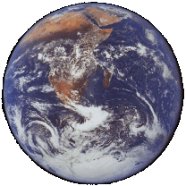The atmosphere of Earth can be divided into distinct layers. One benefit our atmosphere is that it blocks
certain harmful types of radiation. The surface temperature on Earth can vary quite a bit but is between -20
degrees Celsius and 40 degrees Celsius most of the time, making liquid water a common thing at the
surface.
The most prominent surface feature on Earth is ocean. We describe five different oceans and they are a feature unique to
Earth. There are large, ancient craters to be found here and there. Let’s take a look at a map of Earth with the most notable
craters highlighted. Most notable is the giant Chicxulub crater, which is thought to have been involved in the mass extinction
of 65 million years ago. Why are there so few craters on the continents of Earth? It is not because we have not been hit in the
past. We got hit just over one hundred years ago, but no crater was formed. Finding an impact crater on Earth is difficult
these days since so many have been erased, but there is a nice big one in Arizona. In February of 2013, something very
large did, in fact, hit Siberia.
So what would happen if a significantly large object hit Earth now? Let’s find out by going to this page from the Astronomy
Department of the University of Maryland.














































